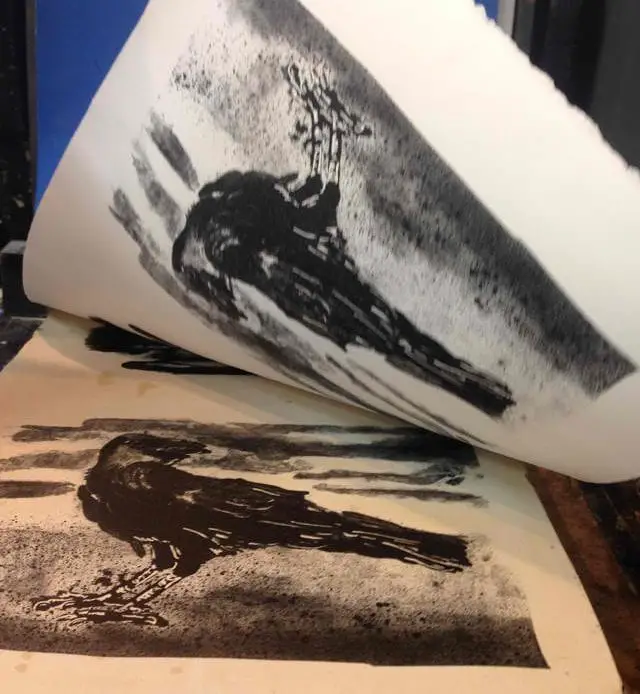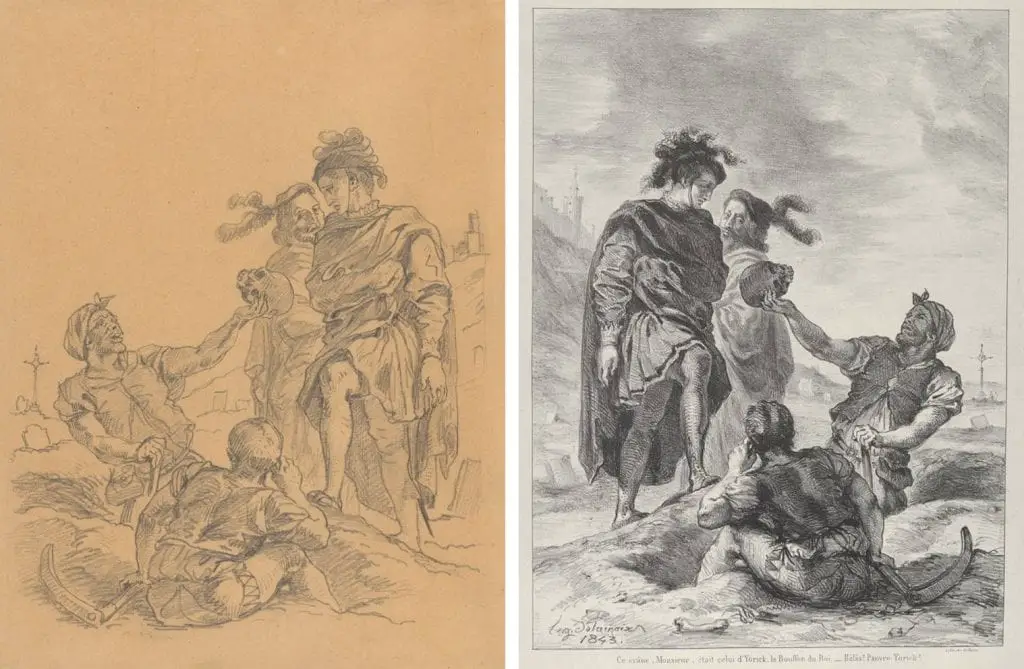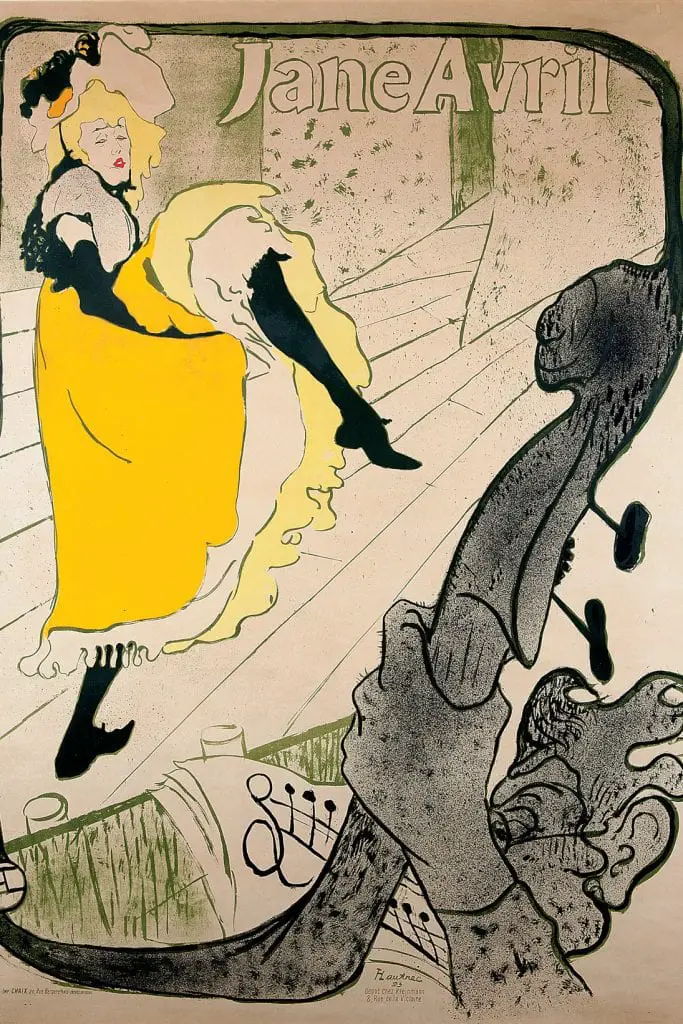
Lithography is the choice of the artists who are not into cutting and engraving as it necessitates drawing skills. A greasy paint is used to create an image on lithography stone, aluminum plate, and zinc. It is a paint that comes in the form of crayons or touché, a kind of ink.
The greasy part where the image is projected attracts the ink while the blank area will be occupied by water. A chemical solution is applied to accomplish this process. It allows the ink to unite with the drawing then it slides off the blank areas. The ink that is left behind the surface will be like being stamped on a piece of paper to create a print.
Background and History of Printmaking Lithography

The word ‘lithography’ is derived from a Greek word, which means ‘writing with stone.’ The inventor of this process is Alois Senefelder, a German who used it as a method of printing text to use in his plays. It was made in 1798, and a year later, a Swiss naturalist named Conrad Gessner published a set of drawings made from lithography in London.
The popularity of lithography was unstoppable. Artists used it as a means of reproduction. They just draw something on the stone and press it on the paper. It helps people conveniently multiply copies. With the benefits this process brought to society, Senefelder received awards, and he continued to work on the improvement of it.
In 1803, the first collection of lithographs was published in London. It is composed of the works of Benjamin West, an American artist, James Barry, an Irish painter, and Henry Fuseli, an Anglo-Swiss artist.
After a year, Berlin saw the first of a series of lithography drawings. Some of them were created by an architect, namely Karl Friedrich Schinkel. In France, lithography became popular because of the numerous artists who showcased their works to the public. They are Eugene Delacroix, Theodore Gericault, Theodore Chasseriau, and Francisco Goya.
Lithography continued to flourish, so both tones and colors are applied to it. The colors blue, yellow, red, and black can be produced by overlapping.
Top Three Lithography Artists

Numerous artists practice lithography, and most of them have already passed away. But their work remains for the public eye to view and appreciate. They just show how lithography is one of the best fine arts.
Here are the three printmaking lithography artists who made it on the top of the list.
1. Henri de Toulouse-Lautrec (1864-1901)
He is a lithographer, painter, and a draughtsman. He was born in Albi, France, on November 24, 1864, to aristocratic parents. Unfortunately, he didn’t completely grow as a result of the inbreeding practice for a hundred years. He was a genetic dwarf.
In 1891, he made his first-ever lithographic poster for Moulin Rouge. He produced 400 black and white and colored prints later on. He also created 40 main posters. He’s not only the first poster designer, but he is a great one, so he was one of the top three lithographers.
He is a man with a strong theatrical sense. He’s interested in an individual’s personality and social extremes. He knows how to show the right kind of style accompanied with elegance. He also uses exaggeration with sardonic sense.
His works immensely contribute to the development of poster making. His style is influenced to a great extent by Japanese ukiyo-e prints. Strong outlines, oblique angles, cropped compositions, and silhouettes are obvious, just like what you can see on the works of Japanese artists like Utagawa Hiroshige and Katsushika Hokusai. The perfect example is the Jane Avril-Jardin de Paris or The Divan Japonais. It depicts visual precision, inventiveness, and cynical elegance with carelessness but quite amusing.
Lautrec’s art may seem artificial, but it appears effective. He shows the reality in life, as seen in his theme of cabarets, dance halls, and circuses. It influenced twentieth-century art history, and even the famous Pablo Picasso was affected by it.
He was able to establish himself as Paris’ premier poster artist. As the 1890s came to an end, his being called for the commission declined as well as his health. He continued working in a private room in a sanatorium, but the shade became somber, and linear emphasis turned aesthetic. He passed away in September 1901 as his family was watching over him.
2. Pablo Picasso (1881-1973)
He is famous for paintings and sculptures, but his works on lithography are also prolific. He engaged in different ways of printing, which is from etching to lithography. He was born in Malaga, Spain on October 25, 1881. He’s recognized as one of the founders of Cubism.
He worked with Fernand Merlout, a master printmaker and he also spent time in Murlout Studios. He made more than 400 lithographs in various mediums. He experimented with these works from 1945 to 1969. He used mixed media, bright colors, plates to make a collage, and even the unconventional method like fingerprinting.
Picasso did it to discover different methods of printing. He wasn’t only able to obtain the kind of print that he desired, but he proved some techniques are reliable and effective. It made his career blossomed. He worked on it for two decades, which is an adequate time for him to explore. His creation covers daily life, a young child, a teacup, a bowl of fruits, and more complex subjects.
One of the famous lithographs that he made is entitled ‘Grand Maternite’ which is a picture of a mother who breastfeeds her child. He also made some of his paintings like Femme Assise into a lithograph.
Picasso’s lithographs are proof of how this well-known artist is a genius in inventing and experimenting with new methods and creations. It is a huge part of his outstanding career, which became a legacy. It is also among the collectibles these days as he made a sheer quantity of lithographs.
3. Marc Chagall (1887-1985)
He was from Belarus, and he had 7 siblings. He is known for his paintings and glass windows, which are a part of Jewish synagogues and Roman-Catholic cathedrals. He has ample knowledge of Cubism and Fauvism.
He learned printing techniques when he was 35 years old as he was living with his wife and daughter in Berlin. It became one of his favorite things to make. His early lithographs creation came up to the total number of 24. He created etchings and woodcuts. He drew the pictures on the paper, and a professional printer converted it into lithographs.
Chagall didn’t master technical printing at first. He came to harness the needed skills for it, starting with his first commission to illustrate books entitled La Fontaine’s Fables, The Dead Souls, and even the Bible. The published time was delayed as the original published, Vollard, died. It came out in 1948, 1952, and 1956.
He was invited by the Museum of Modern Art, located in New York. Then, he stayed in the USA, where he created the series ‘Four Tales from the Arabian Nights’. He finished them in his house in High Falls. They appear in gouaches first then printed out in Albert Carman’s studio in Carman, City Island, New York.
He was also the designer of the stage decorations and costumes of Igor Stravinsky’s ballet performance. It is called ‘The Firebird’ and it was held in New York. His works were exhibited in the Museum of Modern Art New York in 1946, and it was a big success. It was later on displayed in Chicago too.
When he returned to France, he worked regularly with Charles Sorlier in the printing studio of Merlout. It was the time that he made his graphic masterpieces such as Chloe and Daphne. His copies are usually only 50 pieces, which he numbered and signed.
He used paper with watermarks starting in 1950, and they are slightly toned. His work that was published in Derriere le Mirroir and XX Siecle came up around 15,000 copies. He utilized lithograph on almost all occasions like birthday cards and menus. He created a thousand etching and lithography.
He’s recognized as one of the greatest artists who existed in the 20th century. Several museums and art lovers are after his works.
Wrapping it Up for Printmaking Lithography!
It’s interesting to learn how printmaking lithography developed over time. Indeed, there’s always room for improvement. By knowing the works of these amazing artists, you will be able to know the origin of the lithograph and the changes made for the making of good posters. It also contributes a lot to the printing industry. The lithography creations give so many reasons for spectators to be in awe.
